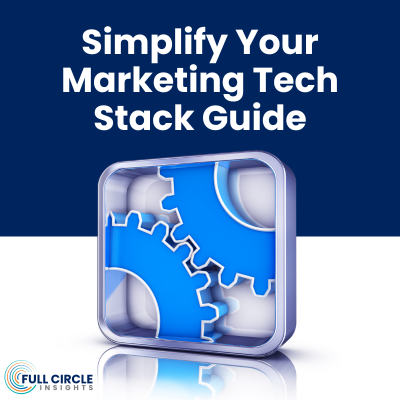Conducting a Marketing Tech Stack Audit Helps Identify Inefficiencies, Reduces Cost, and Improves Performance
As your marketing team grows and evolves, so does your marketing tech stack. At a business’ start-up phase, a one-person marketing team may need all kinds of project management and automation tools to manage freelancers and get a lot done with few resources. When that team grows from one to 100, a basic ABM reporting tool may be swapped for a Salesforce analytics solution that can handle enterprise needs.
Over time, the addition of new tools can create a complicated and potentially inefficient tech stack. You may outgrow and stop using tools you needed a year ago, but still be paying for them. Or, you may have to create time-consuming workarounds for systems you thought would integrate well with each other but don’t.
Fortunately, conducting a marketing tech stack audit can help you identify inefficiencies, reduce costs, and improve performance among your software. Keep reading to learn more about why you should audit your marketing tech stack and how to do it effectively step by step.
Why Do a Marketing Tech Stack Audit?
Reviewing and reflecting on the software solutions your marketing team uses is a useful exercise because it can help you:
- Identify inefficiencies
- Reduce costs
- Improve performance
- Enhance security
- Stay agile
Identify Inefficiencies
As your tech stack grows, it’s easy to accumulate tools you no longer need or don’t use to their full potential. For example, you may no longer need a Canva Pro subscription because you recently hired an in-house graphic designer who uses the Adobe Creative Suite. An audit can help you identify these inefficiencies so you can streamline your software.
Reduce Costs
If you have software in your tech stack that’s redundant or you simply do not use, it could be draining your budget. By identifying and eliminating these tools, you can reduce costs and reallocate resources to more impactful areas of your business.
For instance, instead of having individual licenses for a Salesforce analytics tool, you might be able to save money–and unlock new capabilities–by upgrading to a team plan.
Improve Performance
An audit can help you identify tools that are slowing down your system, causing conflicts, or not integrating well with other tools.
Let’s say you’re using marketing attribution software that has a glitch that forces you to manually transfer data between systems. While it’s inefficient, this workaround might be the easiest way to work with the marketing funnel software because investigating the glitch might be too time consuming to deal with when you have other priorities.
Conducting a tech stack audit can be the perfect opportunity to set aside time to fix glitches once and for all and find tools that work better with each other. By optimizing your stack, you can improve performance and user experience.
Enhance Security
Outdated or unsupported tools can pose security risks to your business. Sensitive internal information and customer data could be stolen, which could pose a big problem for your company reputationally and financially. An audit can help you identify and replace these tools to enhance your overall security posture.
Stay Agile
The marketing tech ecosystem is constantly changing, as is your team. A tool that you overlooked last year may be perfect for your team now. By regularly auditing your tech stack, you can ensure that it remains agile and adaptable to changes in your business.
Perform a Marketing Tech Stack Audit in 9 Steps
Now that you understand why reviewing your marketing tech stack is crucial, follow this step-by-step guide to learn how to conduct your own audit.
1. Define Your Goals
Before you begin the audit, clearly define your goals and objectives. What are you hoping to achieve? Are you looking to reduce costs, improve performance, or enhance security? Get input from all relevant stakeholders.
2. Inventory Your Tools
With your goals in mind, it’s time to create a comprehensive list of all the tools in your tech stack. Consider everything your marketing team uses, from a CRM like Salesforce and Salesforce analytics tools, to email and content creation software. Beyond just naming software, include information about its purpose, who uses it, its cost, usage metrics, and any contractual obligations you have.
3. Assess Tool Performance
Evaluate the performance of each tool in your stack. In addition to considering factors like speed, reliability, scalability, and user feedback, it’s important to analyze the impact the software has had on your marketing efforts.
Has it saved your team countless hours of manual work? Has it helped you identify patterns that have led to more successful campaigns? Think about the value the software has created.
4. Identify Redundancies
Look for redundant tools that perform similar functions. Perhaps your Salesforce analytics solution comes with multi-touch attribution software and marketing funnel software, so you can get rid of standalone solutions for those needs. Consolidate your tools where possible to streamline your stack.
5. Evaluate Costs
Do you really know how much you’re paying for your marketing software? Review the costs associated with each tool, then identify any tools that are over budget or you don’t use enough and consider replacing them with more cost-effective alternatives.
Pro tip: Even if you’re happy with how much you’re paying for a solution, it may be worth shopping around to get a better deal on a similar tool.
6. Consider Security
Evaluate the security of each tool in your stack. Have your passwords been leaked? Have the tools had any security breaches you know about? Do they follow the latest security regulations? Identify any systems that pose security risks and prioritize replacing them with more secure alternatives.
7. Review Integrations
Do all of the pieces in your tech stack play well together? Are there any tools that make you do time-consuming workarounds because they don’t integrate how they’re supposed to? Look for opportunities to improve integration and eliminate any tools that create compatibility issues.
8. Create an Action Plan
Based on your audit findings, create an action plan to optimize your tech stack. Prioritize actions based on their impact on your goals and objectives.
Your first priority may be to consolidate licenses for the tools you want to keep, then find replacements for the tools you no longer want to use.
9. Implement Changes
Once you have an action plan in place, it’s time to kick it off. Don’t forget to monitor the impact of these changes and make adjustments as needed. Be flexible and have backup plans if things don’t go as you had initially planned.
The Bottom Line: Conduct Marketing Tech Stack Audits Regularly
An audit audit isn’t a one-and-done exercise. Just like your business evolves over time, so will your marketing tech stack. Conduct a tech stack audit on a regular basis–at least once per year–to make sure your systems continue to help you achieve your marketing goals.
Learn More About Simplifying Your Marketing Tech Stack
Stacked for Success: The Modern Marketing Tech Stack Revolution webinar




